
Blomer's rivulet is a species of the family Geometridae of moths, in the subfamily Larentiinae which includes the carpet moth and pugs.

The hoary bat is a species of bat in the vesper bat family, Vespertilionidae. It lives throughout most of North America.

The dusky woodswallow is a bird species of forests and woodlands in temperate and subtropical regions, extending into tropical areas around the Atherton Tableland, in eastern and southern Australia. The global population of the species has as yet not been formally confirmed, but it has been officially rated in the range of 'Least Concern', according to the BirdLife International in 2004. As such, the bird could be described as common in its local habitat.

The Hawaiian hoary bat, also known as ʻōpeʻapeʻa, is a species of bat endemic to the islands of Hawaiʻi. Whereas the mainland hoary bat is found throughout North America, the Hawaiian hoary bat is distributed only among the major volcanic islands of Hawaiʻi, making it the only extant and native terrestrial mammal in the state; although some studies also posit that the mainland hoary bat lives in sympatry on the Hawaiian Islands alongside the Hawaiian hoary bat, this has been disputed. The Hawaiian hoary bat was officially named the state land mammal of Hawaiʻi in 2015. It is a federally listed endangered taxon of the United States.

The dusky robin is a small passerine bird native to Tasmania. A member of the Australian robin family Petroicidae, it is known by many other names such as Dozey, Sad, Sleepy, Stump, Tasmania/Wood Robin; Native Sparrow or Sad Bird.
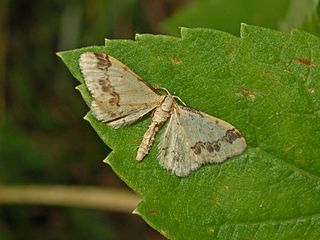
Idaea trigeminata, the treble brown spot, is a moth of the family Geometridae. It is found in Europe.
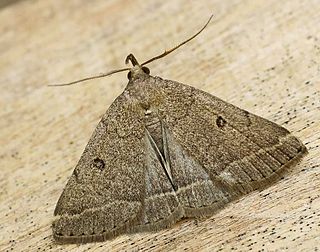
Zanclognatha zelleralis, the dusky fan-foot, is a species of moth of the family Noctuidae. It was described by Maximilian Ferdinand Wocke in 1850. It is found in central and southern Europe.

Ennomos fuscantaria, the dusky thorn, is a moth of the family Geometridae. The species can be found in the western part of the Palearctic realm in western Europe and from central Scandinavia its range extends to the northern Mediterranean and east to Russia.

Tinea semifulvella is a species of tineoid moth. It belongs to the fungus moth family (Tineidae), and therein to the nominate subfamily Tineinae. It is widespread and common in much of the western Palearctic, but seems to be absent from Portugal and the Balkans as well as the outlying islands. The nocturnal adults are on the wing around May to September, depending on the location, and are easily attracted to light sources.

Bityla sericea is a species of moth in the family Noctuidae. This species is endemic to New Zealand. It is classified as "At Risk, Naturally Uncommon" by the New Zealand Department of Conservation.

Mompha langiella is a moth of the family Momphidae. It is found in most of Europe, except parts of the Balkan Peninsula and the Mediterranean islands.

Candalides hyacinthina, the varied dusky-blue, is a species of butterfly of the family Lycaenidae. It is found along the east coast of Australia, including South Australia, New South Wales, Western Australia and Victoria.
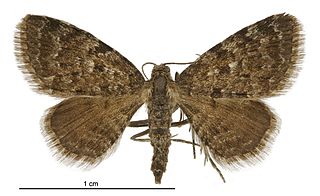
Chloroclystis nereis is a moth in the family Geometridae. It was described by Edward Meyrick in 1888. It is endemic to New Zealand. The habitat consists of mountainous areas.

Pitthea famula is a species of moth in the family Geometridae. It was first described by Dru Drury in 1773 from Calabar, in what is now Nigeria. It is found in Angola, Benin, Cameroon, the Republic of the Congo, the Democratic Republic of the Congo, Equatorial Guinea (Bioko), Nigeria, Sierra Leone and Zambia.
Hydrorybina pryeri is a moth in the family Crambidae. It was described by Arthur Gardiner Butler in 1881. It is found in Japan and Russia.
Compsolechia mangelivora is a moth of the family Gelechiidae. It was described by Walsingham in 1897. It is found in the West Indies, where it has been recorded from St. Thomas and Puerto Rico.

Ogdoconta margareta is a moth in the family Noctuidae. It is found in south-eastern Arizona and Sonora in Mexico.
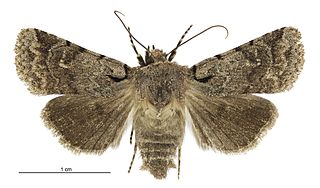
Austramathes fortis is a species of moth in the family Noctuidae. It is endemic to New Zealand and is found in both the North and the South Islands but has yet to be recorded at Stewart Island. It can be found in shrubland containing its host species at a range of altitudes from sea-level up to 1840 m. The larvae of this moth feed on several Melicytus species including M. crassifolius, M. alpinus, M. macrophyllus and M. novae-zelandiae. The larvae pupate in a cocoon of silk at the base of its host plant. It can take between 25 and 45 days before the adult moth emerges. Adults can be found on the wing during the months of July to March. The adults tend to be on the wing in twilight hours but have also been known to be active during the late afternoon. They are attracted to light but this behaviour may limit the number seen at light traps. The distinguishing feature of this moth is the curved black line at the base of its forewing. This species is unlikely to be confused with any other species in its range but it is very similar in appearance to A. squaliolus. However this latter species is only found on the Chatham Islands.

Austrocidaria anguligera is a species of moth in the family Geometridae. It is endemic to New Zealand. It is regarded as being uncommon but is frequently confused with Austrocidaria bipartita.
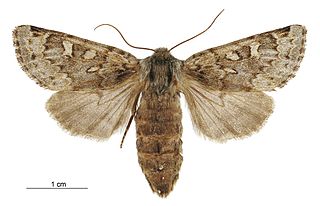
Ichneutica notata is a moth of the family Noctuidae. It is endemic to New Zealand. Although similar in appearance to other species in the Ichneutica genus, it can be distinguished by the colouration and patterns on its wings. It appears to be a very local species, rarely collected and having only been recorded in the north-west of the Tasman District, the Paproa Range, the Rainbow Ski field and the Craigieburn Range. Very little is known of the life history of I. notata.

















